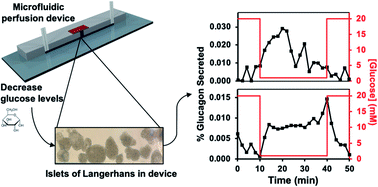A microfluidic system for monitoring glucagon secretion from human pancreatic islets of Langerhans†
Abstract
Glucagon is a 29-amino acid peptide released from α-cells within pancreatic islets of Langerhans to help raise blood glucose levels. While a plethora of methodologies have been developed for quantitative measurement of insulin released from islets, such methods are not well developed for glucagon despite its importance in blood sugar regulation. In this work, a simple yet robust microfluidic device was developed for holding human pancreatic islets and perfuse them with glucose. The perfusate was collected into 2 min fractions and glucagon quantified using a homogeneous time-resolved Förster resonance energy transfer (TR-FRET) sandwich immunoassay. Simulation of fluid flow within the microfluidic device indicated the device produced low amounts of shear stress on islets, and characterization of the flow with standard glucagon solutions revealed response times within 2 fractions (<4 min). Results with human islets from multiple donors demonstrated either a “burst” of glucagon or a “sustained” glucagon release across the entire period of stimulation. The simplicity, yet robustness, of the device and method is expected to appeal to a number of researchers examining pancreatic islet physiology.



 Please wait while we load your content...
Please wait while we load your content...